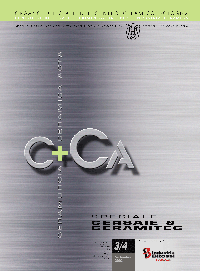- Home
- About us
-
Activities
-
Journals and magazines
-
Meeting and congresses
-
- Contact us

Abstract
Predictions of a mathematical model developed for analysing deviations from rectilinearity of a crack in brittle elastic materials containing a dilute distribution of pores are compared with experimental results relative to some ceramic materials containing spheroidal pores: glazed ceramic tiles and an yttria stabilised zirconia. The investigation involves simple experimental setting, namely crack defection of the median-radial cracks induced by Vickers indentation. This was compared with the predictions of the model. Despite of the strong hypotheses (plane strain and small ratio between inclusion diameter/crack distance) the results are qualitatively accurate. This may suggest the use of the model as a tool to design ceramic porous and composite materials.